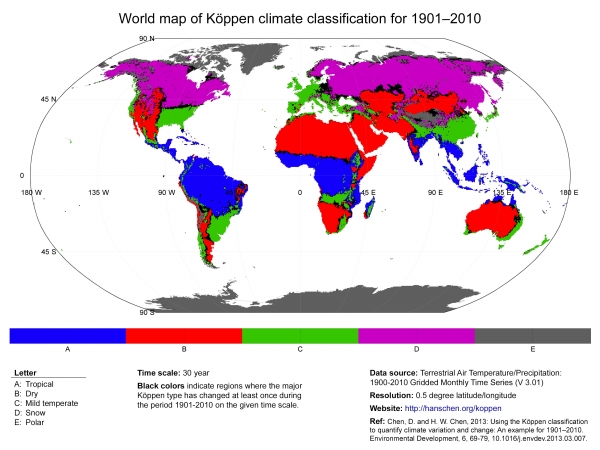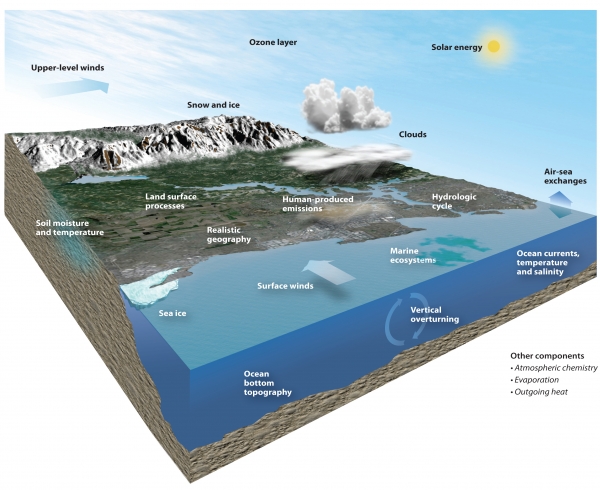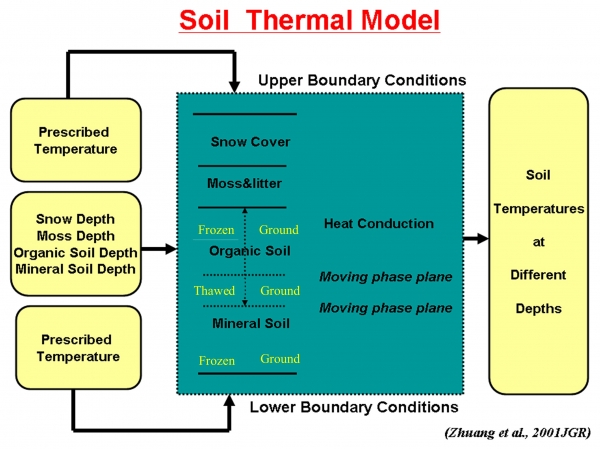MICROMETEOROLOGY
Micrometeorology: -
It is the science of microclimate. This is a branch of meteorology which deals with atmospheric phenomena over few square kilometer areas and within a few meters of height above the ground.
The small-scale variations of meteorological parameters like solar radiation, temperature, wind, vapor pressure and carbon dioxide are studied in respect of their effect on the microclimate above and within plant canopy. These small-scale differences are vital importance in agriculture.
Micrometeorologists are concerned with small scale meteorological phenomenon in the layer of the atmosphere of immediate concern to plants and animals and analysis of the atmospheric layer within which plants and animals live.
Microclimate: - Microclimate is the climate near the ground, i.e. the climate in which plants and animals live. It differs from macroclimate, which prevails above the first few meters over the ground.
Ecoclimate: - Microclimate just above a crop and within the canopy is known as Ecoclimate. It is influenced by a particular type of crop. Very large quantities of energy are exchanged at the surface in the process of evaporation and condensation.
• Wind speed decreases as the surface is approached and its momentum are transferred to it.
• There is a great range of environmental conditions near the surface. And the rate of these changes with time and elevation that make the microclimate. So different from the macroclimate.
Microclimatology: -
It deals with the pertinent factors of the environment in the zone lying between the highest level reached by the plants and the lowest depth to which air penetrates into the soil.
MICROMETEOROLOGICAL DIVISION / layers: -
1. Surface
2. Skin layer
3. Surface boundary layer
4. Plenatory boundary layer
5. Frictionless layer.
1) Surface:
It is a plane separating two media i.e. air and soil. It is an important site for energy and mass exchange and conversion. It receives energy from sun and acts as a source of heat energy.
2) Skin Layer:
• This is a thin layer ranging from few millimeters to 1.5 meters.
• The exchange of energy and mass in this layer is through the process of molecular conduction.
• Surface characteristic is play dominant role for exchange of energy.
• This is the layer of direct significant to plants, animals and man.
• The environment is continuously changing in this layer. The factors responsible for this changes are:
1. Kind of soils and its form
2. Type of plants
3. Variable shading or sunshine
4. Different wind protection methods.
3) Surface boundary layer:
• The thickness of the layer is 50 to 100 m.
• The exchange of energy and mass takes place through eddies or turbulent transfer.
• Temperature variation during day and night are observed in this layer.
• The wind structure is governed by surface characteristics, inhomogenity.
• Total heat in this layer is more than the total at the upper layer.
• Density variation is more pronounced.
• The effect of earth’s rotation is noticeable.
• The weather that prevails in this shallow layer is known as micro-weather or micro-climate.
• These are the two layers with which all living organisms on the surface of the earth are concerned.
Importance of surface boundary layer:
1. Plants, animals and man live in this layer.
2. All transformations are taking place in this layer.
3. Evaporation, ET and frictional wind drag originate at this layer.
4. Exchange processes taking place in this layer affect the agricultural surfaces.
4) PLANETARY BOUNDARY LAYER: -
• The influence of wind is less.
• Temperature variation is very small.
• Air density is very small.
• Vertical motion of entities is less pronounced. Thickness is 100 to 1000m.
5) FRICTIONLESS LAYER: -
• The effect of surface friction is absent.
• The influence of earth’s rotation is dominant.
• Majority of the radiant energy i.e. from radiant to thermal, sensible to latent heat takes place. The transformations of mass i.e. from water to water vapour occur.
• Precipitation is intercepted.
• Resistance on airflow is exerted.
Role of micrometeorology: -
• Problems directly concerned with the life of a plant can be studied with a fair degree of completeness from micrometeorological point of view.
• The diffusion of effluents from the factories. The diffusion of water vapour through evaporation and transpiration from the lakes and fields.
• To study air pollution problems
• The precipitation, fog and frost and its measures to control them and the modification of micro-weather by use of mulches are the problems of direct importance to agriculture and they can best be understood by invoking the principles of micrometeororlogy.
• The above problems also invoke a study of the physiological responses of plant to weather fluctuations and microclimate studies will provide a platform on which the proficiency and experience of meteorologist, agronomist and plant physiologist could be profitably used for improvement of agricultural production.
Physical basis of microclimate:
In order to understand the natural environment of a plant, one should consider a fundamental principle of physics, i.e. the law of conservation of energy applied to the surface over which plant grows.
The earth surface is the active surface at which the energy exchange with atmosphere takes place. The energy exchange at crop surface is represented by the following heat balance equation:
Rn+G+H+LE+P+M=0
A quantitative approximation of heat budget at the ground surface and the relative significance of various factors are fundamental principle of micrometeorology in relation to agriculture.
Influence of soil on microclimate
The soil surface plays a dominant role in establishment of microclimate in different ways:
1. Albedo
2. Soil physical properties
3. Kind of soil and its conditions
4. Temperature near the ground.
Change of Albedo: The land is the uppermost layer which receives and gives off radiation. Albedo or reflectivity is the ratio of reflected radiation to incident radiation (insolation).
0.40 reflection means; ground reflects 40% and absorbs 60%.
Albedo of different surfaces:
Dark cultivated soil : - 7 to 10%
Meadows and crop fields : - 12 to 30%
Fresh snow cover : - 75 to 95%
Green forest : - 5 to 10%
Moist ploughed field : - 14 to 47%
Desert soil : - 25 to 30%
Clouds : - 5 to 85%
Kind and condition of soil
It is an important factor for establishing microclimate in any place.
(1) Temperature near the ground
The temperature near the ground governs the climate near the ground to great extent. Daily heating penetrates deeply into soils. Sandy soils heats up a higher degree in the uppermost layer than granite. But it decreases very rapidly both up and downwards.
(2) Ploughing the soil
Alternation of the soil with deep ploughing affects the heat economy of adjacent air favorably and reduces the frost damage to vegetation. By plowing, kind of soil can be changed, make the soil loose so that it can contain more air, conduct heat much more poorly than any kind of soil. Tillage results in proper heat economy.
(3) Moisture content
It influences the temperature condition and its adjacent air. High conductivity corresponds to moist soil.
PROFILES OF METEOROLOGICAL ELEMENTS
Microclimate in respect of radiational, thermal, moisture and wind regimes prevalent in the field is represented in terms of profiles of net radiation, air temperature, soil temperature, vapour pressure, wind speed and carbon dioxide.
Radiation profile
The amount of radiation at the top of the plant canopy is different from the amount of radiation at the ground surface. The amount and intensity of radiation decreases exponentially with decreasing height in a crop canopy.
The distribution of net radiation within a plant community can be expressed by Beer’s law: -
I = Ia e-kf
Where, I = Intensity of light at a particular height
Ia = Light intensity at the top of the vegetation
k = Extinction coefficient
f = Leaf area index.
The value of k varies from 0.3 to 0.5 for upright leaves and 0.7 to 1.0 for horizontal leaves.
The factors affecting radiation profile: -
1. Leaf arrangement
2. Chlorophyll content of leaf
3. Plant density and height
4. Time of the day
[1] Leaf arrangement: -
Generally leaves are displayed vertically in a plant a rarely horizontally. Erect or vertically displayed leaves allow 44 % of radiation to transmit to ground surface, whereas horizontally displayed leaves transmit only 10 % of light to the second layer.
[2] Chlorophyll content: -
It influences the transmissibly of light through the leaf. The transmissibility decreases linearly with an increase in the chlorophyll content. However, it varies with the Age, size and colour of leaves.
• Broad leaves of evergreen plants have a value of 2 to 8 % and the leaves of decious trees, grasses, cereals, herbs etc have a value of 5-10 % transmissibility.
• The transmissibility of young leaves is higher, then it declines when matured but again rises when it turns yellow.
[3] Plant density and height: -
The interception of light by canopy increases with the increase of plant height. The intensity of light decreases with increases of plant density.
[4] Time of the day: -
Light interception is minimum a noon and maximum during morning and afternoon hours. It depends on the inclination or angle of the sun.
♣ Radiation profile: -
The radiation profile at various heights within a corn canopy on a summer day is depicted in the figure below:
The average hourly solar radiation and net radiation at various heights within a corn canopy on a summer day is given in the above figure.
• The figure indicates that the intensity of radiation is increasing from morning to afternoon with a maximum at 12 noon and then it gradually decreases in the evening.
• The amount of radiation is decreasing at different heights within a plant canopy and is minimum at ground surface.
►Net radiation profile of a clear day: -
The net radiation profile of a clear day is sharply different from that of a cloudy day. On a clear day the upper leaves retain a greater proportion of energy whereas on a cloudy day the energy is evenly distributed (Fig.2)
♣ Temperature profile: -
It is a general fact that temperature decreases with height, but this statement must be notified for conditions near the ground. The expression for temperature as a function of height above the ground is called the temperature profile.
Diurnal variation of air temperature: -
A typical plot of air temperature during a day is given in the above figure (Fig.3)
• The figure indicates that high temperature is the typical of day time in a clear day and cooler temperature is typical of night.
• Both day and night temperature extremes are found at the ground surface.
• For a given height, greater difference in temperature is found near the surface than further above.
• The highest temperature is typical of mid afternoon (about 2pm) in a clear day and the minimum is the lowest just before sunrise.
The air temperature rises more rapidly in the morning than it falls during the afternoon. Rate of fall of temperature in the afternoon is smaller than the rate of rise in the morning. This is because, in the morning, the heat is being dissipated by evaporation and the soil heat reservoir is being refilled. The arrival of energy from the sun is more than the rate of heat dissipated by evaporation and the heat is added to soil. But in the afternoon, soil is not the site for accumulation of heat, but it supplies heat to the surface and to the air near the surface. Hence, it retards the fail of temperature till the next morning.
Temperature profile within crop canopy: -
In presence of crop, main heat exchange centre is raised to just below the top of the crop canopy.
At night, LWR emitted from the crop gave rise to a temperature minimum just below the crown. So that temperature increases upwards in the atmosphere and downward within the vegetation.
• By night the principal site of net radiation absorption is near the canopy crown. So this is the level of maximum heating. Hence, the temperature decreases both upward and downwards and the sensible heat is carried up into the air and down into the crop. Hence during day we feel cool and at night we feel warm a tree.
Soil temperature profile: -
• The figure indicates that by day the temperature decreases with increase in depth and during night the temperature increases with depth.
• Practically no variations beyond 50cm depth.

Climate classification
Micrometeorology
Soil thermal model

